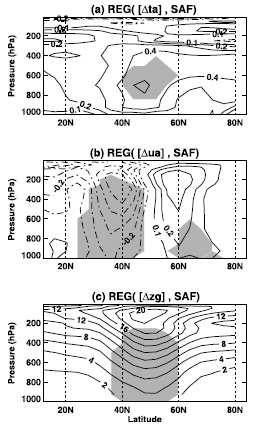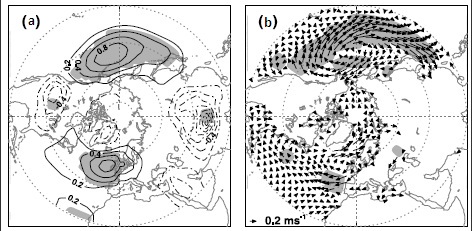
|
||||||||||||||||
|

Climate Feedbacks Circulation response to snow albedo feedback in climate change Climate change is expected to cause a reduction in the spatial extent of snow cover on land. This will lead to local amplification of the greenhouse gas-induced warming and drying through the snow-albedo feedback (SAF) mechanism. In this study, we team up with a Canada research group to examine nonlocal influences of SAF on the summertime circulation in the extratropical Northern Hemisphere using 17 general circulation models. We find that in models with stronger SAF, the land surface warms faster than the ocean, driving surface convergence over the land and divergence over the ocean. This induces opposite-signed anomalies in sea level pressure between the continents and northern oceans and the subsequent poleward intensification of the quasi-permanent high pressure patterns (Fig. 1a). The near-surface wind response also reflects this poleward shift, with the climatological westerlies strengthened around 60N and weakened around 40N (Fig. 1b). The association
between SAF and the circulation response to climate change also
extends to the free atmosphere. Stronger SAF is related to a
broad region of mid-tropospheric warming centered on 50N (Fig.
2a) and a dipolar zonal wind response that peaks in the upper
troposphere and that appears to be in thermal wind balance with
the warming (Fig. 2b). Consistently, the geopotential response
corresponds to increased thickness throughout the troposphere in
the 40N-60N region where SAF is strongest (Fig. 2c). This zonal
mean response connects stronger SAF with a poleward shifted
subtropical jet (Fig. 2b) and with relatively enhanced dry
static stability in the mid-latitude lower troposphere (Fig.
2a).
Figure 1. (a) Projection of the response to climate change (defined as the difference between the time means for the 22nd Century and the 20th Century) in mean sea level pressure on the snow albedo feedback (SAF) index (defined as the difference in surface albedo between the time means for the 22nd Century and the 20th Century normalized by the difference in surface air temperature). (b) As (a) except for 1000 hPa wind vectors. Contour interval in (a) is 0.2 hPa and negative contours are dashed. Reference wind vector is shown in bottom left of (b). Shading denotes responses that are statistically significant (p<0.05) as determined by a Studentí»s t-test. 
Download the publication (Fletcher et al. 2009) describing these results in more detail. |
|||||||||||||||

